You respond to a fire in a semiattached private dwelling, and you’re assigned to search the floor above the fire. As part of the search team, you size up the fire floor along with all members of your team. The initial hoseline is in place and operating. Based on current conditions, your officer decides that a search of the floor above is a viable option. This happens in the fire service worldwide every day.
On the fire floor, you start your search immediately, looking for the fire. You find the fire and alert the engine company as to the location of the fire and the best access to the fire area. As you search, you are always looking for a secondary means of egress. On the floor above, you search toward a secondary means of egress. If you or your unit places a portable ladder to a window, porch, or porch roof, you should communicate that ladder’s location to units inside the building.
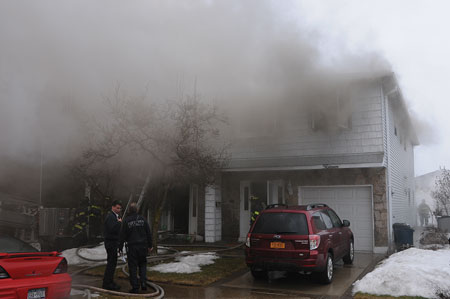 |
| (1) The fire was in a two-story semiattached private dwelling; it started on the first floor. (Photos by Steve White.) |
At this fire in Staten Island, New York, the assigned units operated as per the Fire Department of New York’s standard operating guidelines and proceeded to the second floor in a two-story semiattached private dwelling. The members were informed of the fire’s location and the status of the attack line and made their move to search the floor above. While they were on the floor above, fire conditions deteriorated and the situation changed rapidly. A member was making his way to the secondary means of escape from the second floor: a portable ladder thrown to an elevated porch.
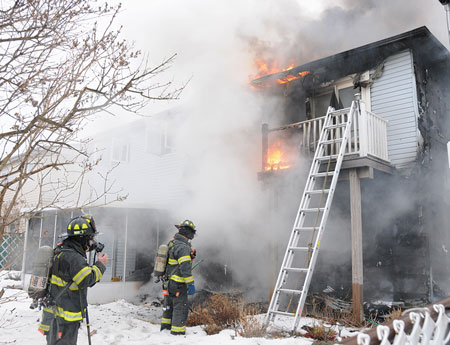 |
| (2) A view of the rear of the building. You can see how the fire started on the first floor, exposed the outside of the building, and traveled to the soffits. This allowed fire to get into the attic space. |
The nature of the building, the construction type, and the fire conditions allowed the fire to travel and get into the attic area. Outside fires tend to travel up the exterior walls and involve combustible siding and expose the soffits. Once the fire involves the soffit, because of construction and soffit vents, expect the attic to become involved. The construction of the roof allows the fire exposing the soffits to spread to the attic quickly and, depending on construction, might cause rapid fire spread within the attic space.
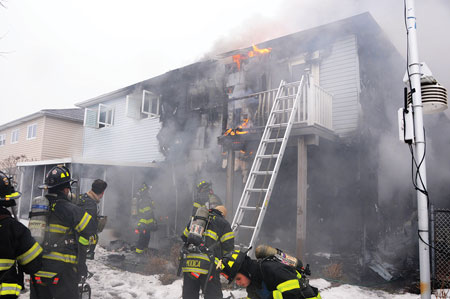 |
| (3) A portable ladder was placed at the second-floor porch as a secondary means of egress. Because of the fire’s progression, this ladder might not be a viable option for members on the interior. |
The members on the second floor might have a large volume of fire over their heads. Handle any fire that involves the exterior walls from the exterior with a handline before it reaches the soffits (if staffing permits). If the fire has involved the soffits and, therefore, most likely the attic, immediately notify members operating on the top floor. A hoseline will also be required on the top floor, and truck companies should pull ceiling when the handline is in place and ready to operate. Operating units should expect a ceiling collapse, especially in newer buildings of lightweight construction.
Importance of Survival Training
Sometimes we can do everything right and still have issues at a fire. Therefore, firefighters and officers operating in a fire building should have self-survival skills. Classes such as “Saving Our Own” and “Get Out Alive” teach firefighters and officers skills to rescue or remove themselves from a hostile environment if things go bad. These skills are vitally important. They allow you to recognize a dangerous situation and remove yourself from it.
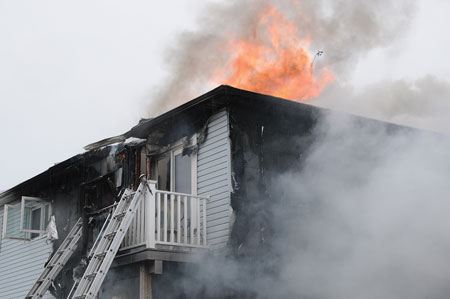 |
| (4) Fire in the attic space intensified rapidly; two additional ladders were placed to windows on the second floor. It is vital to communicate the location of these ladders to members on the interior of the fire building. |
There are some rules, though. First, use self-rescue skills as a last resort when other options are not available. This is not a routine escape from a fire; only perform bailout techniques when all other options are not viable and life safety is in question. Second, department members should train in these skills before they are interior-certified firefighters. Many fire academies and the Fire Department Instructors Conference International offer these classes. If you have not taken a class or your department has not offered one, make it happen; it is a self-survival skill and should be required of every interior firefighter.
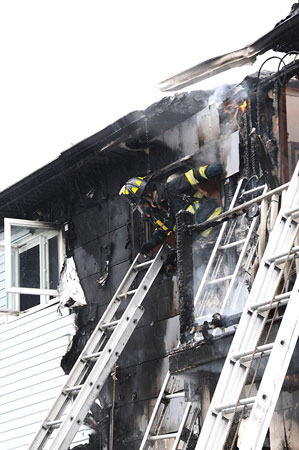 |
| (5) A member operating on the interior of the fire building was trapped by the intensifying fire and collapse of the top-floor ceiling. He made his way to a window and prepared for a head-first ladder slide. |
At this fire, the member was trying to make his way to the secondary means of egress, the rear porch deck. His route to the primary egress point was cut off by a ceiling collapse caused by a rapidly advancing fire in the attic space. He made it to a rear window and knew that a ladder was present and he could make his escape. Members on the exterior of the fire building had placed portable ladders, and he could exit the building quickly and safely.
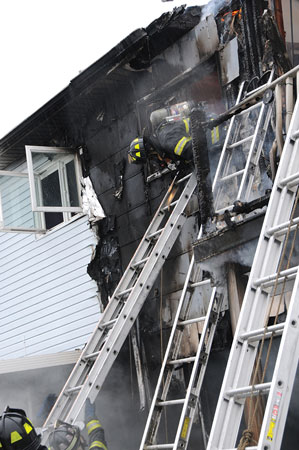 |
| (6) The firefighter exited the window head first to stay low in the window below the heat and fire. |
He acted according to his training and, because of fire conditions, exited the window low and head first over the windowsill. Grabbing the ladder, he removed himself from the hostile environment and danger from the fire and had a second or two to decide what he was going to do. He performed a 180° turn and descended the ladder feet first after getting out of the dangerous situation. The members outside on the ground stayed off the ladder, allowing the member room to turn and align with the ladder. This was a textbook exit and done only because the conditions warranted it.
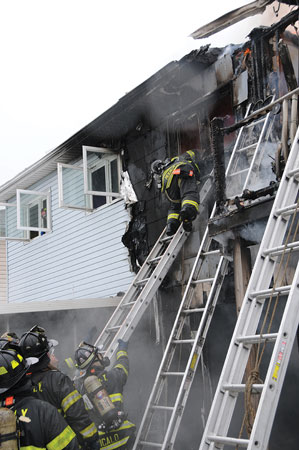 |
| (7) The member was allowed room on the ladder to spin and come around to a feet-first descent. Members at the base of the ladder braced it for safety. |
Bailout techniques are vital skills for all interior firefighters, and all interior members should be trained in these life-saving skills. They are a last resort to get out alive. Hopefully, you will never need the skills, but if you are in a situation and don’t have them, by then it will be too late to learn them.
MICHAEL M. DUGAN is a 27-year veteran of the Fire Department of New York, where he served as captain of Ladder Company 123 before retiring in 2012. As a lieutenant, he served in Ladder Company 42 and was a firefighter in Ladder Company 43. He has been involved with the fire service for 39 years.
Throw Back to Basics: Bailout
STICKNEY ROOF RACK BAILOUT
Training Minutes: Firefighter Self-Rescue
Fire Engineering Archives

